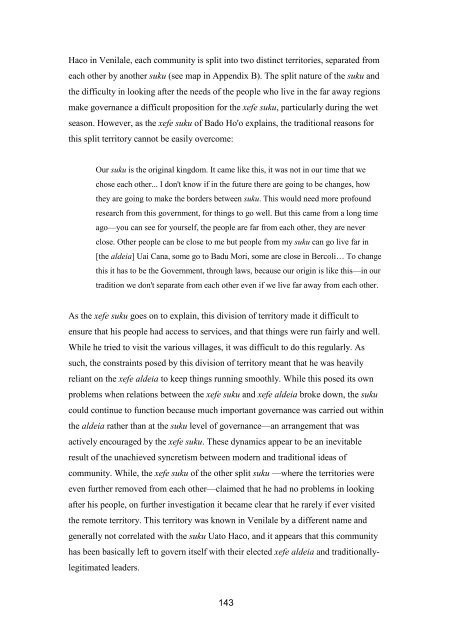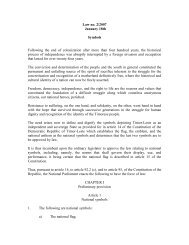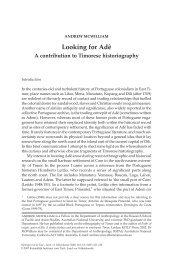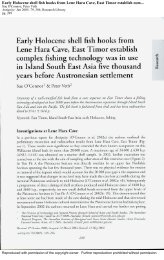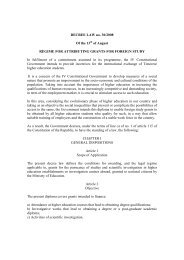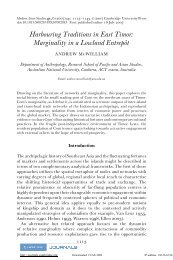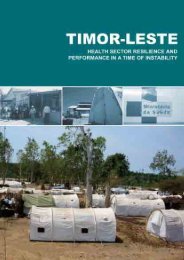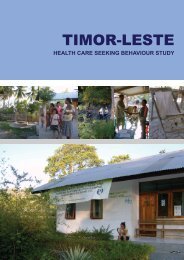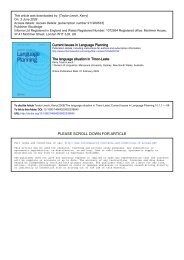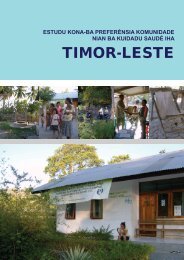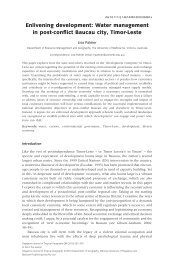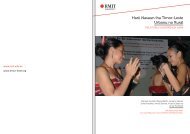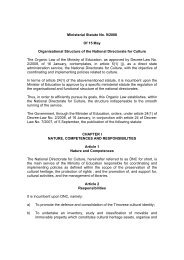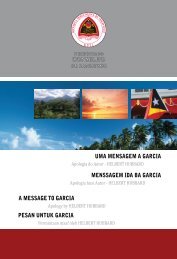Local Governance in Timor-Leste - Secretaria de Estado da Arte e ...
Local Governance in Timor-Leste - Secretaria de Estado da Arte e ...
Local Governance in Timor-Leste - Secretaria de Estado da Arte e ...
- No tags were found...
Create successful ePaper yourself
Turn your PDF publications into a flip-book with our unique Google optimized e-Paper software.
Haco <strong>in</strong> Venilale, each community is split <strong>in</strong>to two dist<strong>in</strong>ct territories, separated fromeach other by another suku (see map <strong>in</strong> Appendix B). The split nature of the suku andthe difficulty <strong>in</strong> look<strong>in</strong>g after the needs of the people who live <strong>in</strong> the far away regionsmake governance a difficult proposition for the xefe suku, particularly dur<strong>in</strong>g the wetseason. However, as the xefe suku of Bado Ho'o expla<strong>in</strong>s, the traditional reasons forthis split territory cannot be easily overcome:Our suku is the orig<strong>in</strong>al k<strong>in</strong>gdom. It came like this, it was not <strong>in</strong> our time that wechose each other... I don't know if <strong>in</strong> the future there are go<strong>in</strong>g to be changes, howthey are go<strong>in</strong>g to make the bor<strong>de</strong>rs between suku. This would need more profoundresearch from this government, for th<strong>in</strong>gs to go well. But this came from a long timeago—you can see for yourself, the people are far from each other, they are neverclose. Other people can be close to me but people from my suku can go live far <strong>in</strong>[the al<strong>de</strong>ia] Uai Cana, some go to Badu Mori, some are close <strong>in</strong> Bercoli… To changethis it has to be the Government, through laws, because our orig<strong>in</strong> is like this—<strong>in</strong> ourtradition we don't separate from each other even if we live far away from each other.As the xefe suku goes on to expla<strong>in</strong>, this division of territory ma<strong>de</strong> it difficult toensure that his people had access to services, and that th<strong>in</strong>gs were run fairly and well.While he tried to visit the various villages, it was difficult to do this regularly. Assuch, the constra<strong>in</strong>ts posed by this division of territory meant that he was heavilyreliant on the xefe al<strong>de</strong>ia to keep th<strong>in</strong>gs runn<strong>in</strong>g smoothly. While this posed its ownproblems when relations between the xefe suku and xefe al<strong>de</strong>ia broke down, the sukucould cont<strong>in</strong>ue to function because much important governance was carried out with<strong>in</strong>the al<strong>de</strong>ia rather than at the suku level of governance—an arrangement that wasactively encouraged by the xefe suku. These dynamics appear to be an <strong>in</strong>evitableresult of the unachieved syncretism between mo<strong>de</strong>rn and traditional i<strong>de</strong>as ofcommunity. While, the xefe suku of the other split suku —where the territories wereeven further removed from each other—claimed that he had no problems <strong>in</strong> look<strong>in</strong>gafter his people, on further <strong>in</strong>vestigation it became clear that he rarely if ever visitedthe remote territory. This territory was known <strong>in</strong> Venilale by a different name andgenerally not correlated with the suku Uato Haco, and it appears that this communityhas been basically left to govern itself with their elected xefe al<strong>de</strong>ia and traditionallylegitimatedlea<strong>de</strong>rs.143


